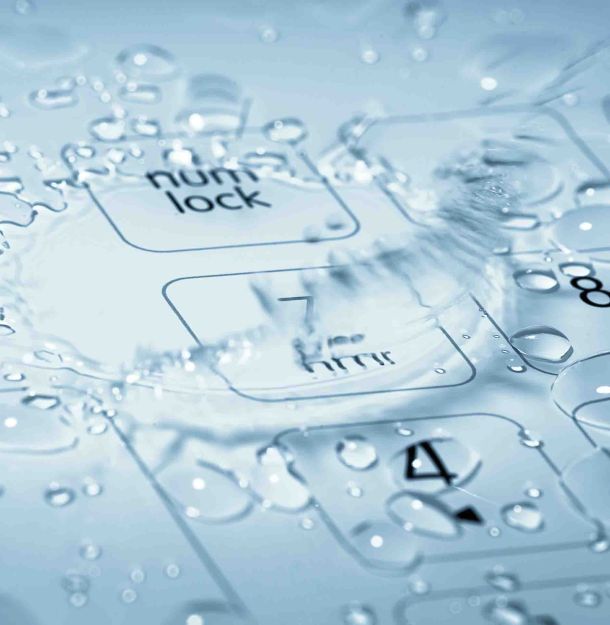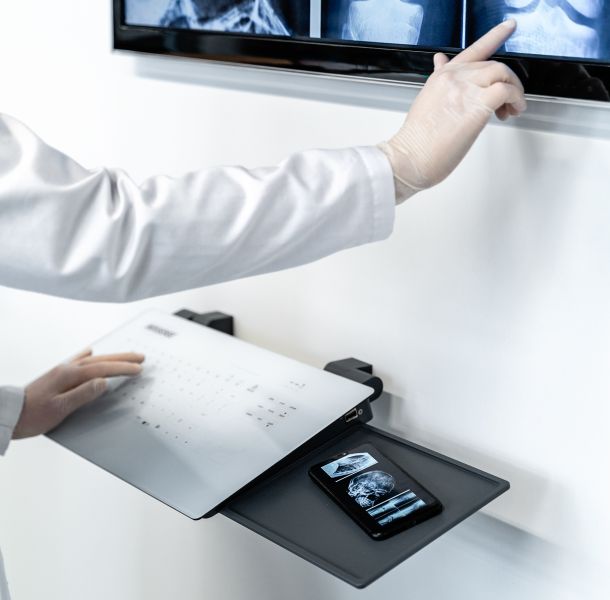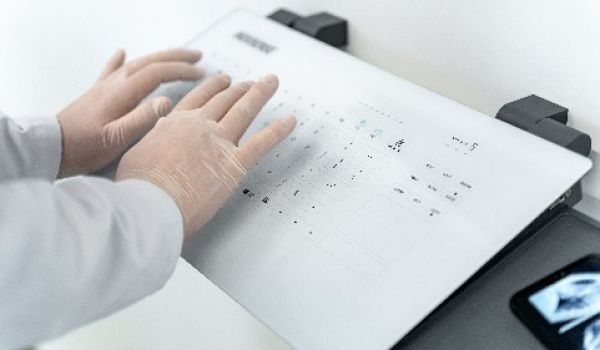
DIFFERENT ASPECTS WHEN USING GLASS PANELS
In part 2 of my blog article on the topic of capacitive operating solutions today, I particularly want to deal with the aspects of design, hygiene, environmental effects and haptics.

Aspect II: Hygiene
The issue of cleaning and hygiene is very important for many of our customers. This is particularly true in times where there is an increased risk of infection – e.g. in regular flu epidemics or the Covid-19 pandemic at the moment. The clear goal is to avoid as many sources of danger as possible to prevent infection. It is important here that the necessary hygiene and disinfection measures, which are predefined for the relevant areas, can provide their maximum effect.
Operating panels made of glass and their options have a clear advantage, particularly in this respect.
Glass is basically an extremely robust material. IP protection ratings on the front are no problem. Its resistance to cleaning and disinfectant agents is excellent, as the design print is normally located on the rear.
The smooth, enclosed surface is, firstly, not prone to any dirt – and, secondly, it is possible to clean it easily without any “dirt-collecting edges”, with just one wipe, as it were.
Integrating a capacitive operating panel within a work surface can be a good solution here too. It is even sensible to use the space for other purposes, if the keyboard is switched off and not being used.
However, the glass may still break, which is a major disadvantage. Even if we use hardened glass, which has better properties in this regard, breakage cannot be fully ruled out. Alternatively, it is possible to use materials like acrylic glass (also known as Plexiglass®), polycarbonate (also known as Markrolon®, Lexan®) or Corian®, if their properties are suitable.
There is absolutely no doubt that a glass input panel is clean and hygienic!

Aspect I: Design
The issue of design is both exciting and very complex, in my view. The “new” surface involving glass as an operating element opens up a wealth of design options and is therefore completely in line with the latest trend. Who does not think that a high-class glass panel is stylish?
Developers have to consider several parameters material:
- The material thickness
- The printing
- The glass processing
- The shape and size of the operating elements
A smooth, transparent material provides an incentive to play with colors and shapes. There is a great deal of freedom when designing operating panels.
The shape of the keys in each case emerges from the interplay of the geometry of the key element and the printing of the cover material, which normally takes place on the rear. If there is already set hardware available for the key surfaces, the print design can still be adapted to a certain degree in terms of the shape of the keys, colors (CI) and logos.
This saves costs for hardware development and the necessary certification – e.g. EMC. The design of the key surfaces themselves is much freer than when using predefined mechanical keys too.

Aspect III: Environmental effects
A capacitive keypad is naturally exposed to a wide variety of environmental factors too.
The challenge here involves ensuring that keys are not triggered by a defined amount of force applied to the key, as on classic keyboards, but through activating an electric field via a change of capacity.
This particularly applies when it comes to water on the keyboard.
>> Side note: Did you know that 75% of muscle tissue consists of water? <<
Even our fingers, which we use to operate the keys, largely consist of water.
It is therefore not that easy to recognize what is actually next to or on a key.
This includes residual moisture from cleaning procedures, for example.
Depending on the usage, there are various ways of minimizing these effects. They include recalibration if particular variables change, key debouncing times or certain algorithms when assessing the key parameters and switch-off functions for cleaning.
However, there is still one huge advantage … there are simply no crumbs in the keyboard or it does not give up the ghost because a cup of coffee has been spilt on it.
Aspect IV: Haptics
One issue that is hotly contested again and again is the lack of sensation of any key pressure. Opinions differ widely on this point.
Depending on the usage and personal preferences, there are widely differing opinions here – and it is true that it is also partly a generation issue. My experience shows that the generation, which has grown up with smartphones, has far fewer problems with glass.
There are very different ways of handling this requirement:
- Acoustic feedback in the form of key peeps or even a realistic key click
- Optical feedback with an LED
- Vibrating feedback
- Key-simulating feedback
- Perceptible finger guides
Not each solution makes sense in each situation. A key sound can disturb people, vibrating glass has its limits if the keypads are fairly heavy and a finger guide is necessary for “blindly” operating actuators like sliders or control dials.
Customers sometimes ask for almost touch-free operations. This eliminates all the processes that require good finger contact with the glass. If the latter is not available, you cannot sense any vibration or movement of the surface.
Despite this, the issue of “haptics” is very high on our ‘to-do list.’ I am sure that we will be able to solve this challenge in the near future too.
In my view, the issue of haptics also involves preventing any incorrect activation of keys, which is caused by the lack of operating force. I can mention one solution here as a practical example, which is being used in a machine operating panel used by a GETT customer. The practical tests showed that the operators were inadvertently activating keys by leaning on the glass panel. We solved this by embedding the keys in a surface sensor. This guaranteed that the keys were only activated if deliberate operations took place on the key surface, but not if the whole field was “activated.”
My personal conclusion…
Firstly, I hope that I’ve been able to shed more light on some aspects of glass operating panels. I can summarize by saying that this operating technology has huge potential. However, it is also important to know about the challenges that you face in order to obtain the best solution, and not just the first one that is available.
It is my or our aspiration to support and advise you along this journey.
See you again soon!
Jens Kieselbach
These topics could also interest you...

Capacitive glass operating panel

Industrial panel PC


